As someone who started their gardening journey with zero knowledge, I understand how overwhelming it can be to get started. That’s why I highly recommend “Grow Green Thumbs: A Guide to Beginner Gardening Plants” for anyone interested in starting their own garden. This guide offers comprehensive details for people with yards of all sizes, emphasizing how to choose the right plants for success.
It’s important to consider factors like location, available time, and purpose when selecting what to grow. This guide provides a list of fruits and vegetables that thrive in specific seasons and offers resources for finding what produce is in season in different areas. It also advises on determining the ideal gardening spot based on sunlight and moisture levels and offers tips on choosing the right plants for different environments. Proper watering, sunlight exposure, and soil quality are also discussed in detail, with recommendations for beginner-friendly plants such as Sansevieria, succulents, peace lilies, and African violets.
Key Takeaways:
- Consider location, yard size, and available time when starting a garden.
- Choose plants based on the specific season and environment, including sunlight and moisture levels.
- Proper watering, sunlight exposure, and soil quality are crucial for plant health.
- Beginner-friendly plants include Sansevieria, succulents, peace lilies, and African violets.
- Regular maintenance is necessary to remove weeds and prevent pests.
Factors to Consider Before Starting Your Garden
The first step is to consider factors such as location, yard size, and gardening time availability when starting your own garden. You will want to choose a spot that receives enough sunlight and has good drainage, as well as one that is protected from extreme weather conditions. It is important to determine what type of garden you would like to have, whether it be a vegetable garden for sustenance or a decorative garden for aesthetics. Knowing which fruits and vegetables grow well in your area based on the season is also essential.
When selecting plants, it is important to consider the level of gardening knowledge you possess and any potential hazards that may arise for children or pets. Choosing beginner-friendly plants, such as herbs and leafy greens, is a great starting point. This will also help you learn the basics of gardening and become more confident in your abilities.
Having the right tools is also essential for a successful gardening experience. Basic supplies such as gloves, shears, and watering cans are a must-have for any gardener.
Remember to regularly tend to your garden, removing weeds and protecting it from animals. Plants are living organisms and need care and attention to thrive. Whether you acquire plants through transplanting, seed sowing, or propagation, it is important to consider your climate when choosing plants, as different species have different temperature and sunlight requirements.
Growing your own plants can have numerous benefits, such as increased oxygen, free food, and a sense of tranquility. With these gardening tips for beginners in mind, you can start growing your own plants and enjoying the many benefits of gardening.
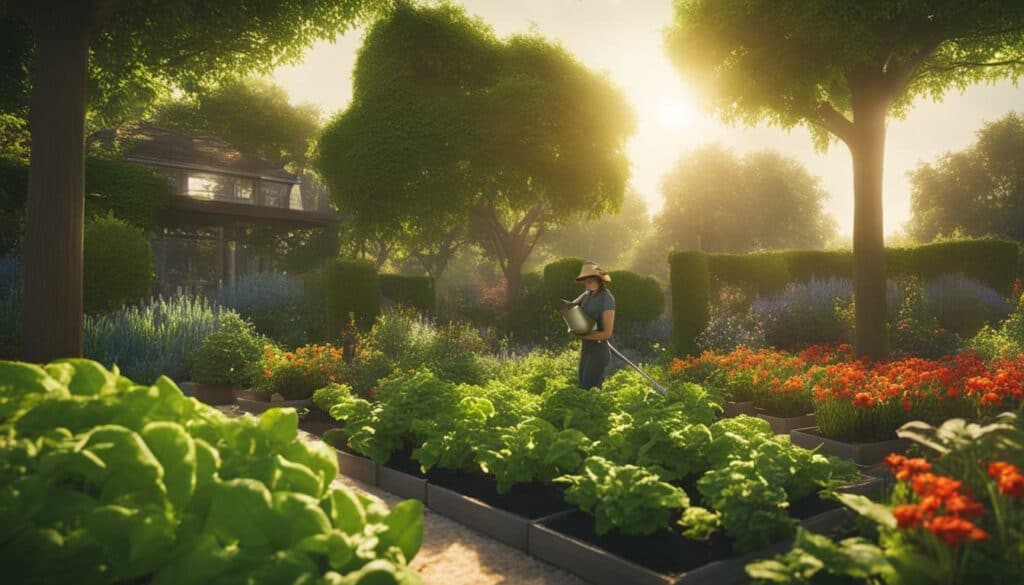
Choosing the Right Plants for Your Garden
Resources like Seasonal Food Guide and the USDA’s Family Garden Planning Guide offer information on what fruits and vegetables grow best in specific seasons. As a beginner, it’s important to choose plants that are easy to grow and maintain. Look for beginner-friendly plant species, such as marigolds, pansies, and petunias for decorative plants, and cherry tomatoes, lettuce, and carrots for beginner-friendly vegetable plants.
Consider your garden’s purpose when selecting plants. If you want to grow your own food, choose plants that are suitable for eating and grow well in your area. If your garden is purely for decoration, focus on plants that are aesthetically pleasing and add color to your space. Additionally, consider the space each plant requires and choose plants accordingly, ensuring they have enough room to grow.
| Factor to Consider | Description |
|---|---|
| Your location | Choose plants that thrive in your region and climate. Research which plants grow the best for your area. |
| Yard size | Consider the size of your yard and choose plants that fit comfortably in the space. |
| Amount of sunlight | Take into account the amount of sunlight your garden receives and choose plants that require the appropriate amount of light. |
| Toxicity of plants | If you have children or pets, consider the toxicity of certain plants before choosing them for your garden. |
Remember to also choose plants that suit your level of experience. While some plants require more attention and maintenance, others are more forgiving and easier to care for. Always read the labels and make sure you understand the plant’s requirements before purchasing and planting it in your garden.
It’s important to note that plants are living beings that require care and empathy. Regularly tending to your plants by removing weeds and providing them with proper nourishment and attention will keep them healthy and thriving. Providing the right amount of water and sunlight is also crucial for their survival. Make sure to give them enough water without overwatering, and ensure they receive the appropriate amount of sunlight based on their individual needs.
By choosing the right plants for your garden and providing them with proper care, you can enjoy the numerous benefits of gardening, such as increased oxygen, free food, and a tranquil environment.
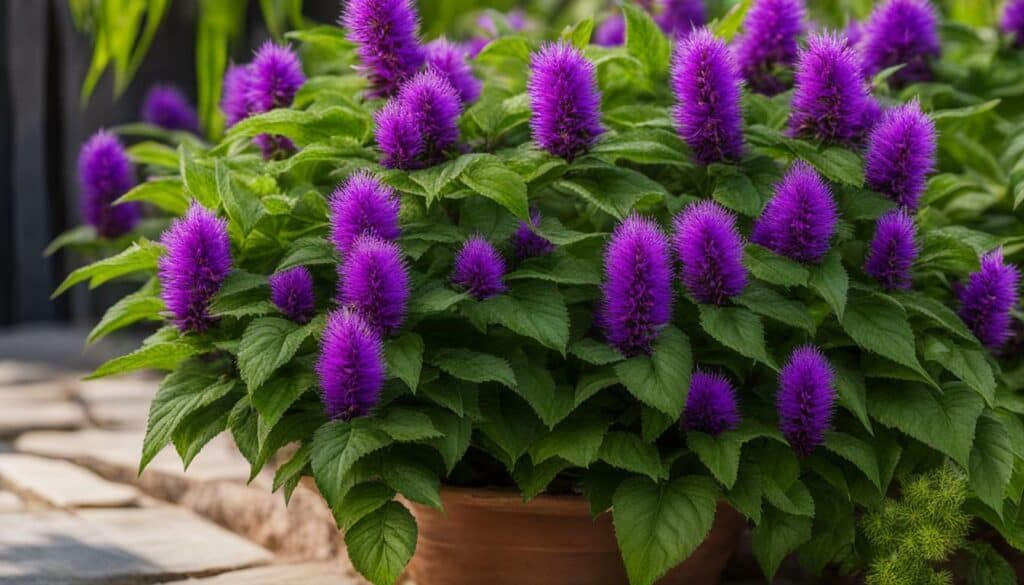
Selecting the Ideal Gardening Spot
Choosing the right gardening spot is crucial, considering sunlight exposure and drainage. It is important to find an area that receives six to eight hours of sunlight. However, if you plan to grow vegetables such as cabbage or carrots, they can tolerate less light. Ensure the spot is not shaded from trees or buildings to prevent stunted growth.
Other than sunlight, proper drainage is essential for the health of your plants. Avoid areas with moist soil as it can lead to root rot and other diseases. Look for areas with well-draining soil or create raised beds for optimal drainage.
Consider the purpose of your garden, whether it’s for sustenance or decoration. Choose the appropriate plants accordingly. If the goal is to have a flower garden, consider plants such as sunflowers or marigolds. If the goal is to grow vegetables, consider easy-to-grow plants like tomatoes or lettuce.
Once you have found the ideal spot, provide your plants with adequate care, water, and sunlight. Regular maintenance, such as weeding and pest control, will prevent weed growth, protect plants from pests and diseases, and ensure a healthy garden. With the right knowledge and tools, even beginners can create a thriving garden in no time.
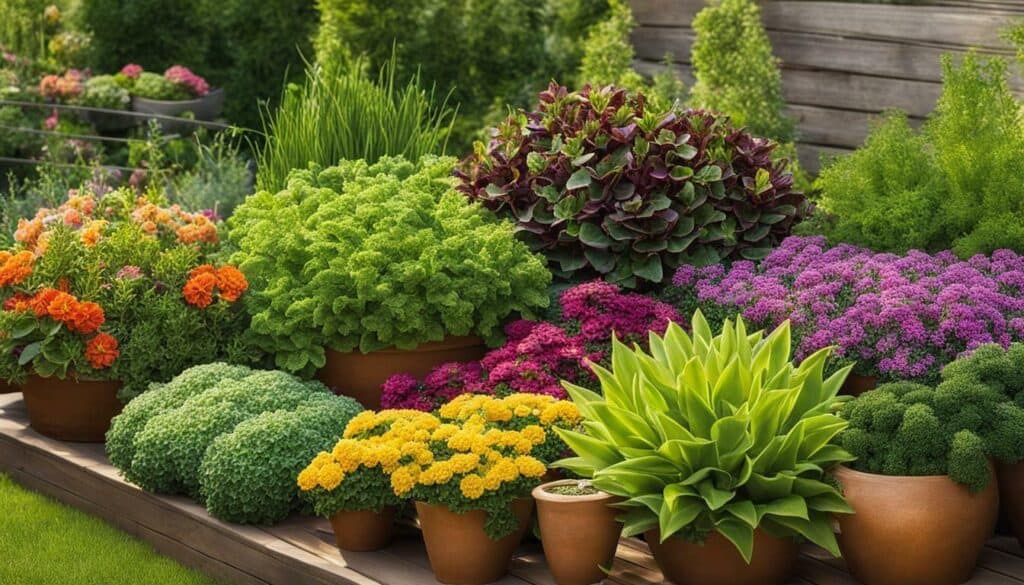
Essential Gardening Tools
Necessary gardening tools include gloves, shears, a rake or garden hoe, a garden fork or spade, a garden hose or watering can, and rich soil. These tools are crucial for both beginners and experienced gardeners to grow and maintain a healthy garden.
Gloves are essential to protect your hands from thorns, prickly stems, and rough surfaces. Shears or pruners help trim plants and make clean cuts without damaging the stems. A rake or garden hoe is useful for smoothing and breaking up dirt and moving soil. A garden fork or spade is necessary for digging holes, uprooting weeds, and planting bulbs and seedlings. A garden hose or watering can is important for efficient watering and providing necessary nutrients to plants.
In addition to acquiring the right tools, it is important to regularly tend to plants, remove weeds, and protect them from animals. Acquiring plants through transplantation, seed sowing, or propagation is also essential, and it is important to consider the climate and environmental factors when choosing plants for your garden.
Overall, with the right tools and knowledge, gardening can be a rewarding and fulfilling experience. Investing in good quality tools and regularly maintaining them will ensure that your garden thrives and you are able to enjoy the fruits of your labor.
Maintaining Your Garden
Regular maintenance such as removing weeds and tending to plants is important for any beginner gardener. Careful planning and understanding of the specific needs of the plants you choose to grow is crucial for successful gardening. It’s also important to consider factors such as your location, the size of your yard, and the amount of sunlight it receives to determine which plants will thrive in your space.
Once you’ve chosen the right plants for your garden, selecting the ideal gardening spot is essential. Choosing an area with proper sunlight exposure and good drainage will help your plants grow strong and healthy.
As you tend to your garden, investing in the right gardening tools and equipment, such as gloves, shears, and watering cans, will make the process easier and more enjoyable. Providing the right amount of water and sunlight, regularly fertilizing your plants, and repotting as needed are also important steps in maintaining your garden.
Pruning your plants for both health and aesthetics can encourage growth and improve their overall appearance. It’s also important to clean the leaves of your plants to prevent pests and ensure their continued health. Remember, plants are living organisms, and treating them with care will result in a successful and rewarding gardening experience.
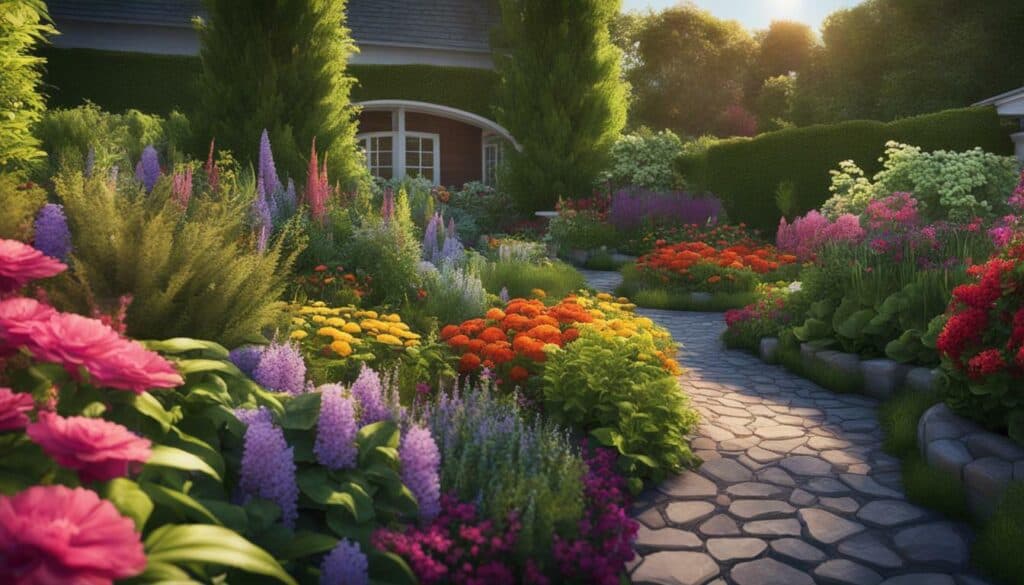
Proper Watering and Sunlight Exposure
Proper watering and sunlight exposure are vital for plant health and are two of the most important factors to consider when starting your beginner garden. Before planting, determine the amount of sunlight your yard receives and the specific needs of the plants you want to grow. Some easy to grow plants for beginners such as tomatoes, cucumbers, and peppers require at least six to eight hours of direct sunlight, while others such as lettuce, kale, and spinach can thrive with less light.
The location of your garden can play a significant role in your plants’ growth and health. Avoid areas with excessive shade or moisture that can harm the development of your plants. For beginner gardening plants, we recommend selecting a spot with easy access to water and good drainage.
When it comes to watering your plants, it is essential to find the perfect balance. Over-watering can cause root rot, while under-watering can cause your plants to wilt and die. As a rule of thumb, plants need about an inch of water per week, but the amount can vary depending on the type of plant and its environment.
Avoid watering your plants during the hottest parts of the day as water droplets can magnify sunlight and burn the leaves.
Transplanting established plants, sowing seeds, or propagating new plants are three ways to acquire new specimens for your garden. It is important to understand the climate and environmental conditions of your region to select the right plants and ensure their survival.

By following these guidelines for proper watering and sunlight exposure, you can become a successful and nurturing gardener, allowing your plants to flourish. Remember to provide them with the right amount of water and sunlight and choose the right location for your garden. Your green thumb is just a few steps away!
Fertilizing and Repotting Plants
The guide suggests repotting plants when they outgrow their pots and pruning to maintain their health and appearance. Fertilizing plants at the right time is also essential to provide them with the nutrients they need for healthy growth.
When starting a garden, it is important to choose the right size and type of pot for the plants. Plants that outgrow their pots will have stunted growth and become root-bound, leading to a decline in their health. A general rule of thumb is to choose a pot that is one size bigger than the current one.
When repotting, it is essential to choose a pot with good drainage holes to prevent waterlogging and root rot. The soil used should be a good quality, well-draining mix that provides enough nutrients for the plants.
Fertilizing is necessary to provide plants with the nutrients they need to grow and flourish. It is recommended to use a slow-release fertilizer every 6-8 weeks to ensure continuous nutrient availability. It is important to follow the manufacturer’s instructions and not over-fertilize, as this can harm the plants.
Regular pruning, such as removing dead leaves and branches, helps maintain plant appearance and promotes new growth. Cleaning the leaves with a damp cloth helps prevent pests and keeps plants healthy.
By providing the right care, fertilizing, and repotting when necessary, beginner gardeners can ensure their plants thrive and grow successfully.
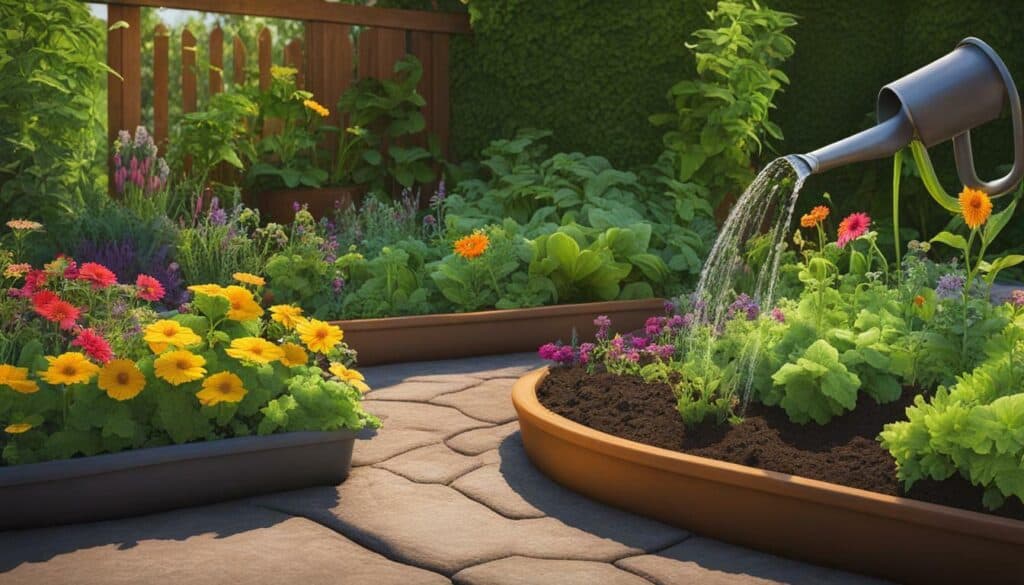
Maintaining Plant Health and Appearance
Finally, it emphasizes the importance of cleaning plant leaves to prevent pest growth. Maintaining plant health and appearance is critical in gardening, whether you have a small herb garden or a large estate garden. Choosing plants suitable for your specific location, such as those that can withstand your climate and sunlight requirements, is an important step towards maintaining healthy plants.
Providing the right amount of water and sunlight is necessary for optimal plant growth. It is recommended to water plants early in the morning or late in the evening when the temperature is cooler and to avoid getting leaves wet to prevent fungal growth. Plants that require direct sunlight should be placed in an area that receives at least six hours of sunlight per day.
Regular maintenance is necessary to keep plants healthy and looking good. Pruning, removing weeds, and preventing pest infestations are critical components of plant care. Pruning promotes healthy growth and removes any dead or diseased leaves and branches. Weeding helps prevent the spread of diseases and ensures plants are receiving necessary nutrients. Pest infestations can be prevented by using natural pest control methods or commercial products.
Acquiring plants through transplanting, seed sowing, or propagation allows for a variety of options in maintaining a garden. Transplanting allows for established plants to be introduced into new spaces, seed sowing provides a cost-effective way to grow plants from scratch, and propagation is an excellent option for those interested in growing a specific plant.
By understanding the living nature of plants and their basic needs, gardeners can develop a strong connection with their green companions and enjoy the benefits they provide, such as increased oxygen, free food, and a peaceful environment.
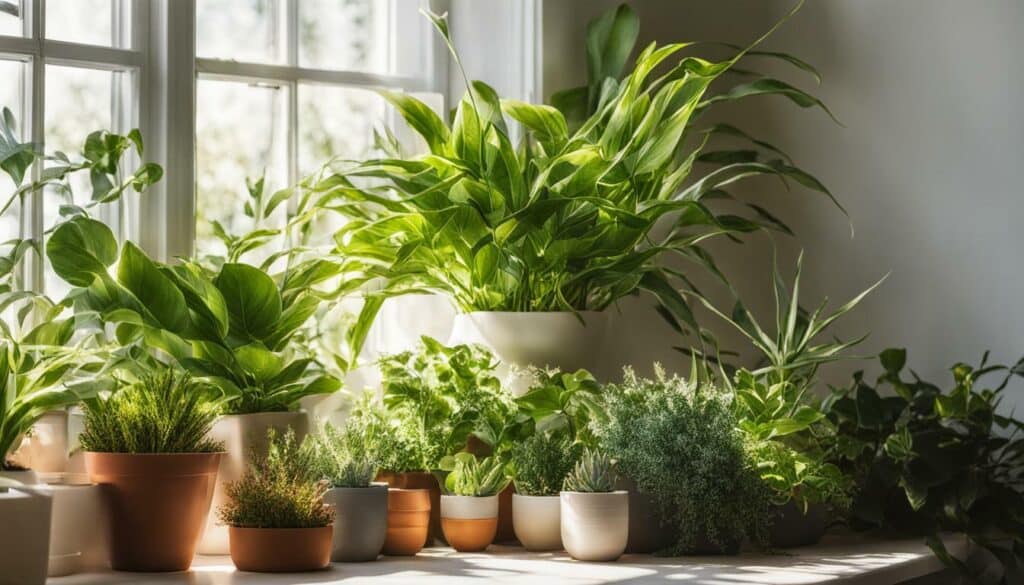
In summary, maintaining plant health and appearance can be a rewarding experience for beginner gardeners. Choosing the right plants, providing adequate water and sunlight, regular care, and acquiring plants through different methods are all essential components of gardening. Remember to give your plants the TLC they deserve, and in no time, they will reward you with a lush, green garden.
Conclusion
Overall, the guide provides valuable information and tips for beginner gardeners. Growing plants not only provides beauty to your home but also various benefits such as increased oxygen, free food, shade, tranquility, and exercise. There are three ways to acquire new plants, transplanting, sowing seeds, or propagating from existing specimens. When choosing plants, it is important to consider the climate they will be grown in to ensure they thrive. Taking care of plants involves understanding their basic needs for water, sunlight, and protection, as well as regularly tending to them and removing any weeds or pests. By giving plants the necessary care, they will flourish and provide lasting enjoyment.
FAQ
Q: What factors should I consider before starting my garden?
A: Before starting your garden, it is important to consider factors such as location, yard size, and gardening time availability.
Q: What are some beginner-friendly plants I can choose for my garden?
A: For decoration, you can choose plants like Hydrangeas, Vinca, and Delphinium. For beginner vegetable gardening, consider plants like Bell Peppers, Cucumbers, and Tomatoes.
Q: How do I choose the right gardening spot?
A: When choosing a gardening spot, consider factors such as sunlight exposure and drainage. These factors are crucial for the health and growth of your plants.
Q: What are the essential gardening tools I will need?
A: The essential gardening tools include gloves, shears, a rake or garden hoe, a garden fork or spade, a garden hose or watering can, and rich soil.
Q: How do I maintain my garden?
A: Regular maintenance is important for your garden. This includes removing weeds, tending to plants, and ensuring proper watering and sunlight exposure.
Q: When should I fertilize my plants and repot them?
A: Fertilize your plants at the right time and repot them when they outgrow their pots. This will help maintain their health and ensure proper growth.
Q: How do I maintain the health and appearance of my plants?
A: To maintain the health and appearance of your plants, clean their leaves regularly to prevent pest growth and keep them looking their best.
Note: This HTML structure can be further improved with CSS styles and additional semantic tags if necessary.
Source Links
- https://plantcareforbeginners.com/articles/houseplants-101-how-to-get-a-green-thumb
- https://portfarms.com/finding-your-green-thumb/
- https://gardenerspath.com/how-to/beginners/growing-plants-101/
- https://www.orbitonline.com/blogs/learn-and-grow/growing-green-thumbs-a-guide-to-starting-a-school-garden-or-garden-club
- https://www.amazon.com/How-Create-Garden-Free-Plants-ebook/dp/B00XQWX7UO
- https://www.almanac.com/10-tips-beginner-gardeners
- https://miniurbanfarm.com/things-to-know-before-starting-a-garden/
- https://rootedrevival.com/six-things-before-planting-your-first-garden/
- https://www.realhomes.com/advice/how-to-choose-plants-for-your-garden
- https://www.homesandgardens.com/gardens/best-plants-for-beginners
- https://www.gardeningetc.com/advice/best-plants-for-beginners
- https://sebsnjaesnews.rutgers.edu/2020/04/choosing-the-right-location-for-your-vegetable-garden/
- https://www.almanac.com/where-put-vegetable-garden
- https://www.gardensthatmatter.com/choose-garden-location/
- https://www.gardendesign.com/how-to/tools.html
- https://www.azurefarmlife.com/farm-blog/essential-garden-tools-for-beginners
- https://healthiersteps.com/12-essential-gardening-tools-for-beginners/
- https://www.gardenersworld.com/how-to/grow-plants/gardening-for-beginners-how-to-care-for-your-garden/
- https://www.almanac.com/vegetable-gardening-for-beginners
- https://www.finegardening.com/article/10-ways-to-keep-your-garden-healthy
- https://getbusygardening.com/how-to-determine-sun-exposure/
- https://growinginthegarden.com/gardening-for-beginners-how-to-start-a-garden-in-8-simple-steps/
- https://www.bhg.com/gardening/how-to-garden/understanding-your-yard-s-sunlight/
- https://nestingwithgrace.com/when-to-fertilize-plants-and-repotting-houseplants/
- https://www.bhg.com/gardening/yard/garden-care/why-you-should-fertilize-plants/
- https://www.joyusgarden.com/repotting-plants/
- https://extension.okstate.edu/fact-sheets/basic-plant-care-understanding-your-plants-needs.html
- https://content.ces.ncsu.edu/home-vegetable-gardening-a-quick-reference-guide
- https://www.theartofsimple.net/5-gardening-basics-for-beginners/
- https://www.bhg.com/gardening/yard/garden-care/ten-steps-to-beginning-a-garden/

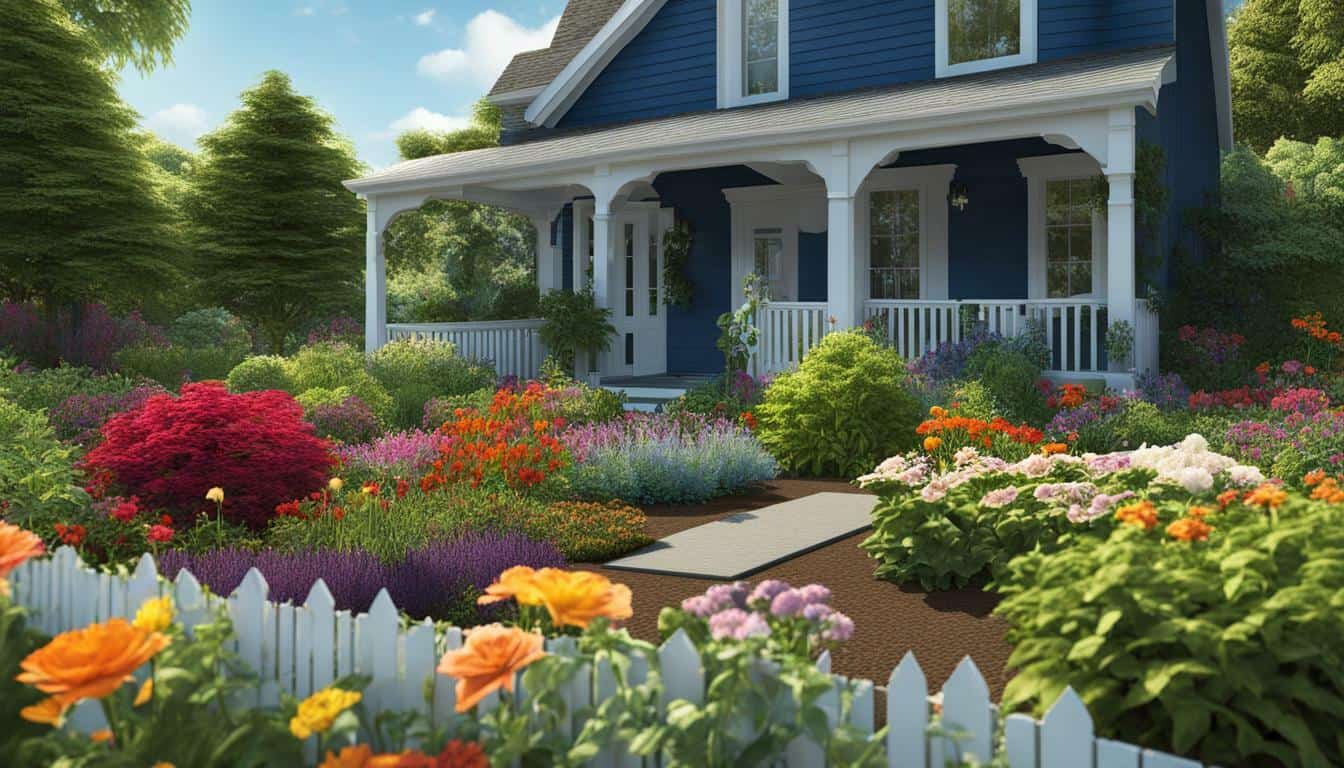



Leave a Reply